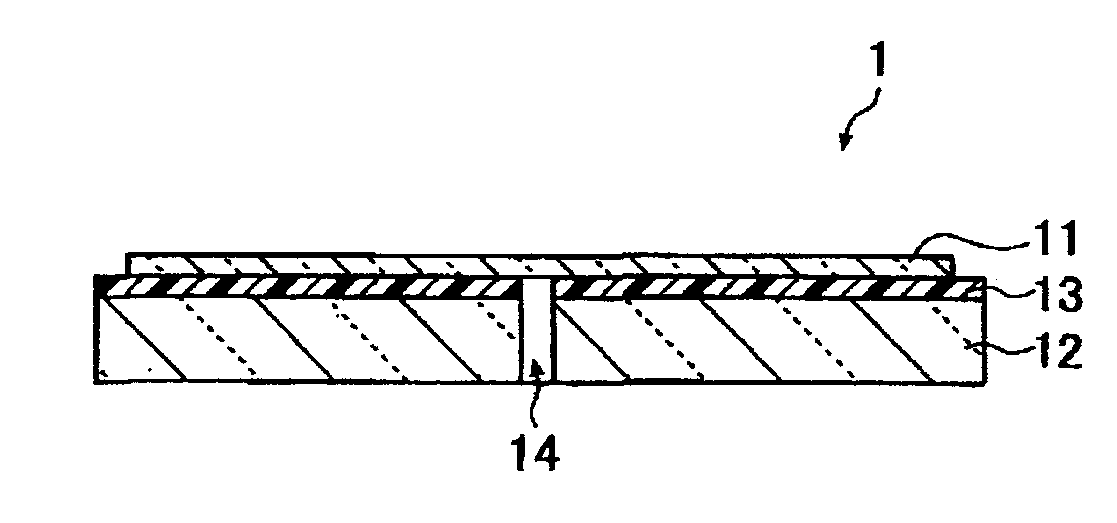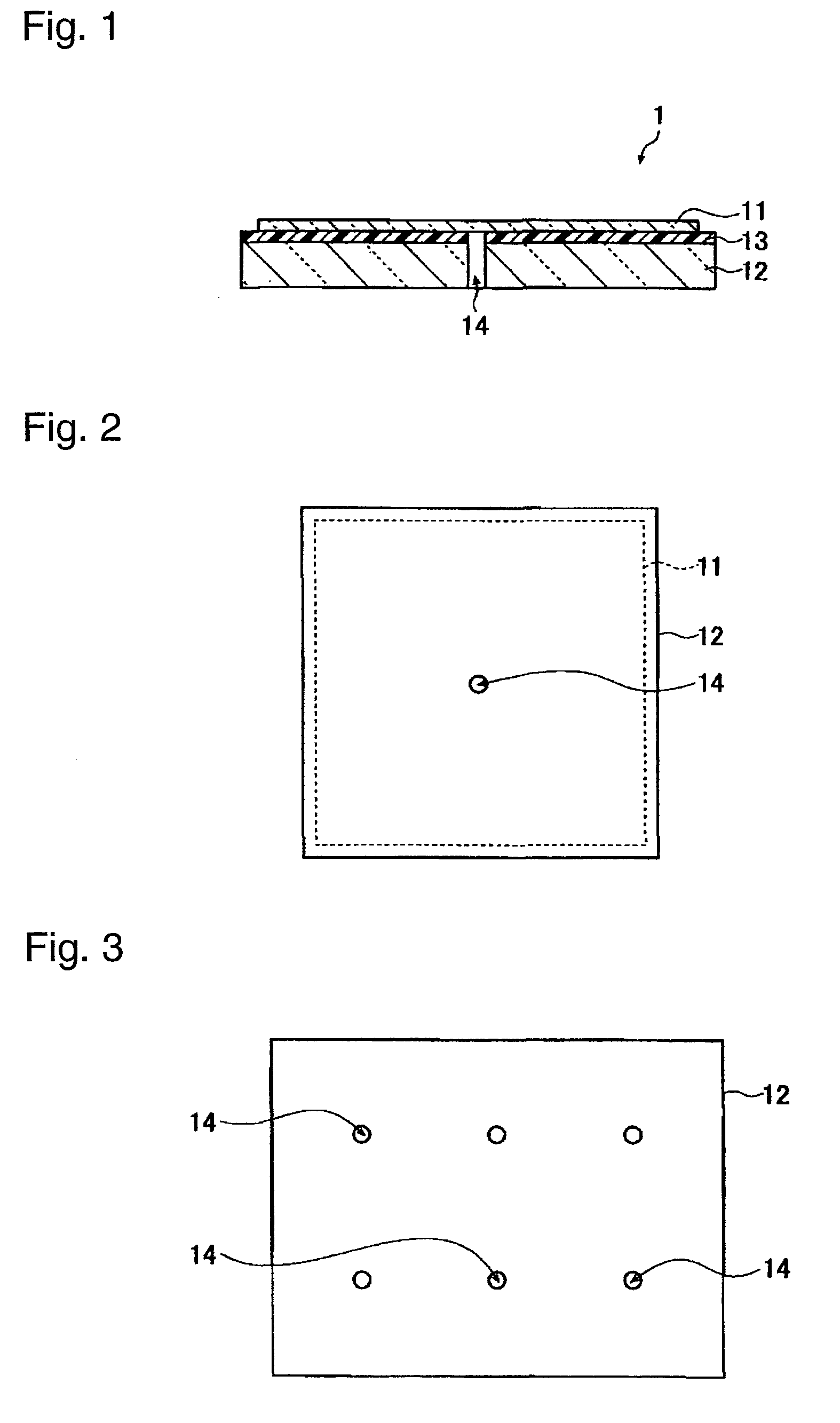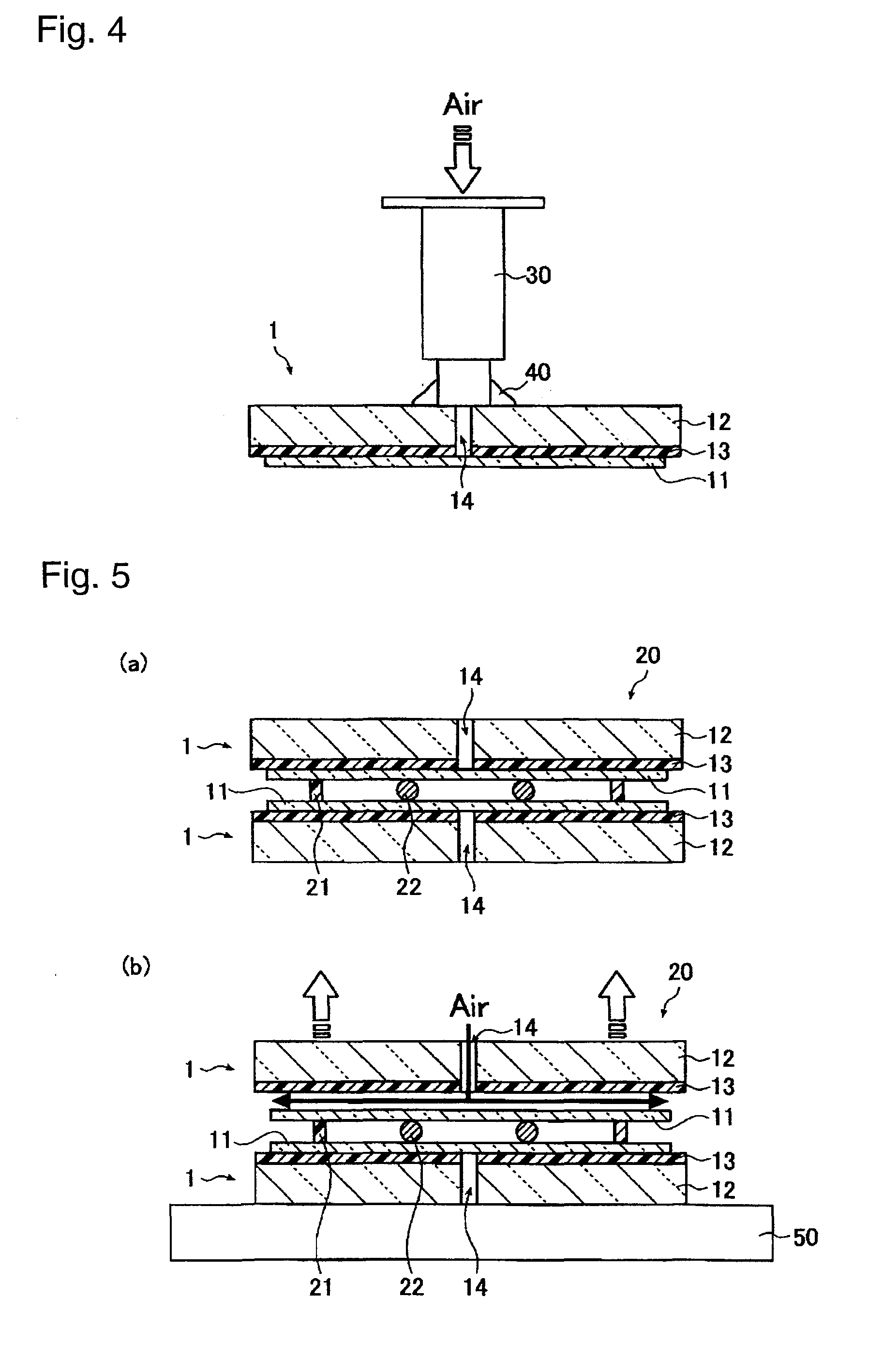Thin plate glass laminate, process for producing display device using thin plate glass laminate, and support glass substrate
a technology of thin plate glass and laminate, which is applied in the direction of instruments, transportation and packaging, synthetic resin layered products, etc., can solve the problems of affecting the production of display devices, the amount of deformation is significant, and the strength decrease becomes problematic, etc., to achieve excellent heat resistance, easy removal, and favorable adhesion properties
- Summary
- Abstract
- Description
- Claims
- Application Information
AI Technical Summary
Benefits of technology
Problems solved by technology
Method used
Image
Examples
example 1
[0126]In this Example, a thin plate glass laminate shown in FIGS. 1 and 2 was produced.
[0127]In the central portion of a support glass substrate 12 (AN100, manufactured by Asahi Glass Company, Limited) of 100 mm×100 mm×0.7 mm thick and having a linear expansion coefficient of 38×10−7 / ° C., a hole 14 of 1.5 mm in diameter was formed by a diamond drill as shown in FIG. 2. The substrate 12 was cleaned by e.g. purified water cleaning and UV cleaning, and coated with a mixed product (application amount 15 g / m2) of 100 mass parts of a non-solvent addition reaction type silicone for release paper (KNS-320A, manufactured by Shin-Etsu Silicone) and 2 mass parts of platinum type catalyst (CAT-PL-56, manufactured by Shin-Etsu Silicone), by a screen printing machine, and the coated product was heat-cured at 100° C. for 3 min in the atmospheric air to form a silicone resin layer 13 of 15 μm thick. A portion of the support glass substrate 12 where the hole 14 was provided, no silicone resin layer...
examples 2 and 3
[0132]The procedure was carried out in the same manner as Example 1 except that the diameter of the hole 14 was changed to 1 mm (Example 2) or 2 mm (Example 3).
[0133]FIG. 7 shows the results of peel tests of Examples 1 to 3. As evident form FIG. 7, when the diameter of the hole 14 increases, the pressure of compressed air required to separate the thin plate glass substrate 11 and the support glass substrate 12 can be lowered. Further, in a case of thin plate glass laminate that was heated at 300° C. for 1 hour, the pressure of compressed air needs to be higher than that of a thin plate glass laminate before heating, but support glass substrate 12 was easily removed from the thin plate glass substrate 11 manually by hand.
example 4
[0134]At predetermined positions shown in FIG. 8 in a support glass substrate (AN100, manufactured by Asahi Glass Company, Limited) of 400 mm×300 mm×0.7 mm thick and having a linear expansion coefficient of 38×10−7 / ° C., seven holes of 1.5 mm in diameter were formed by a diamond drill. The substrate was cleaned by purified water cleaning and UV cleaning etc., and it was coated with a mixed product (application amount 15 g / m2) of 100 mass parts of non-solvent addition reaction type silicone for release paper (KNS-320, manufactured by Shin-Etsu Silicone) and 2 mass parts of platinum type catalyst (CAT-PL-56, manufactured by Shin-Etsu Silicone), it was heat-cured at 100° C. for 3 min to form a silicone resin layer of 15 μm thick. No silicone resin layer was formed on the portions of the support glass substrate where the holes were provided, and holes perforating through the support glass substrate and the silicone resin layer were formed.
[0135]A surface of a thin plate glass substrate ...
PUM
| Property | Measurement | Unit |
|---|---|---|
| Temperature | aaaaa | aaaaa |
| Thickness | aaaaa | aaaaa |
| Thickness | aaaaa | aaaaa |
Abstract
Description
Claims
Application Information
 Login to View More
Login to View More - R&D
- Intellectual Property
- Life Sciences
- Materials
- Tech Scout
- Unparalleled Data Quality
- Higher Quality Content
- 60% Fewer Hallucinations
Browse by: Latest US Patents, China's latest patents, Technical Efficacy Thesaurus, Application Domain, Technology Topic, Popular Technical Reports.
© 2025 PatSnap. All rights reserved.Legal|Privacy policy|Modern Slavery Act Transparency Statement|Sitemap|About US| Contact US: help@patsnap.com



